The Kenko 6x (KDT-60) package has a lens, two lens caps, and a lens pouch (left image below). It is a very compact 6×16 monoscope with a dimension of 2.5in (length)×1.25in (width). The thread size is 28mm and can be directory mounted on a 950/990/995. The document states that this lens also works for 880 series. The CrystalVue Sharp Shooter is a 8×32 monoscope and comes with a lens, two lens caps, rubber eyepiece, protective case with belt loop, and a 28mm-37mm step-up ring for 950/990/995 cameras (right image below). Compared with the Kenko 6x, the Sharp Shooter is a big one with a dimension approximately 5.45in (length)×1.6in (width).
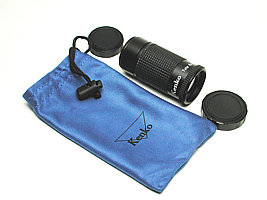
|
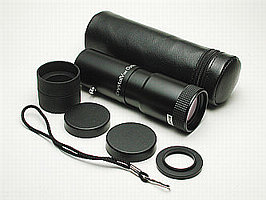
|
| Kenko 6x (KDT-60) | CrystalVue Sharp Shooter 8x |
What do 6×12 and 8×32 mean?Monoscopes and binoculars are associated with a pair of numbers like p×d. Here p means the magnification (or power) of the lens, and d denotes the diameter of the front objective lens in millimeter. Since p tells how much the lens magnifies the object being viewed, a lens with larger p magnifies the object larger. A lens with larger d is brighter because a larger objective lens can collect more light. So, is the Sharp Shooter brighter than the Kenko 6x? To answer this question, we need to know more. The first is the exit pupil e, which is defined as the quotient of dividing the diameter d by the magnification p: e = d / p. Therefore, the exit pupil values of Kenko 6x and Sharp Shooter 8x are 12/6 = 2 and 32/8 = 4. Finally, the relative brightness, or simply brightness b is computed as the square of the exit pupil value e: b = e2. Thus, the brightness values of Kenko 6x and Sharp Shooter 8x are 4=22 and 16 = 42. Therefore, the Sharp Shooter is four times brighter than the Kenko 6x, even though the latter has a higher magnification. This is because the Sharp Shooter 8x front lens is much larger than that of the Kenko 6x. |
The Kenko takes 2.75 turn to go from its minimum focusing distance 23cm (i.e., 9 in) to infinity, and this extends the length of the lens from 2.5 in to 3 1/3 in. On the other hand, the Sharp Shooter requires four full turns to go from its minimum focusing distance 70cm (i.e., 27.6 in) to infinity, and extends the length of the lens from 5.25 in to 6.5in. See the images below for a comparison.
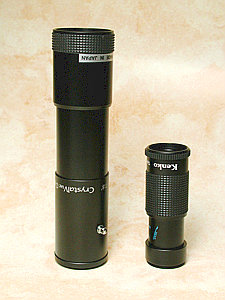
|

|
| Focusing at the minimum distance | Focusing at infinity |
There is no difficulty in mounting both lenses on a 950/990/995. However, since the Sharp Shooter is big and heavy, a 995 user might want to use the swivel lock to prevent the lens unit from swiveled beyond the horizontal position. Moreover, because both lenses can magnify any hand movement, the use of a tripod is highly recommended.
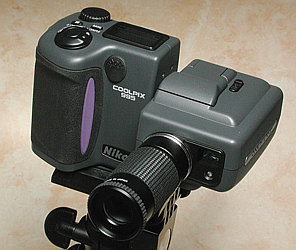
|
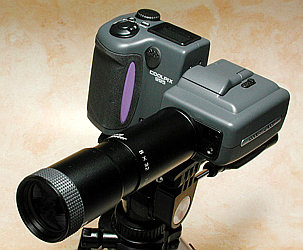
|
| Kenko 6x on a 995 | Sharp Shooter 8x on a 995 |
The Sharp Shooter has a thread size of 37mm, and can also be used on many digital cameras and camcorders if the 28mm-37mm is not used. The following image shows mounting the Sharp Shooter on a camcorder with its original 37mm filter thread.
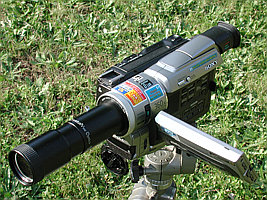
|
| Sharp Shooter 8x on a camcorder |
Kenko 6x and Sharp Shooter 8x both have filter threads. Kenko 6x (resp., Sharp Shooter 8x) has a thread size of 27mm (resp., 37mm). Consequently, using filters is not a problem. The following is a summary:
| |
Kenko 6x | Sharp Shooter 8x |
| Front | 27mm | 37mm |
| Rear | 28mm | 28mm and 37mm |
Because of the front threads, both lenses can be combined with other converters to make a big combo. The left image below shows the combination of a Tiffen 2x and a Kenko 6x, and the right one shows a Tiffen 2x and a Sharp Shooter 8x. They become 12=2×6 and 16=2×8 telephoto converters. However, I do not believe you would use these combos for real work because their quality is not very good.
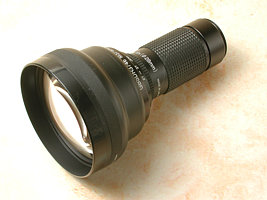
|
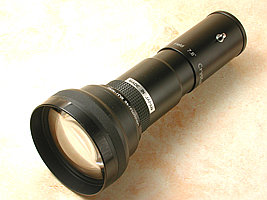
|
| Tiffen and Kenko 6x | Tiffen and Sharp Shooter 8x |
To use both lenses, you should set the camera to the macro mode. In general, you should use the focus ring of the lens to focus on the subject roughly. Then, the camera's autofocus system will take over. Unfortunately, it is easily said than done. Some practice is really necessary, and, as a result, it is very difficult to take action photos because it is not so easy to roughly focus on a moving object. Even though you are able to do so, the autofocus system of your 950/990/995 may not be fast enough to keep up with the movement. Therefore, these two lenses are not for taking action photos. If taking action photos is your main goal, get a SLR with fast lenses.
In the use of these two lenses, one thing bothers me a lot. Since the lenses are screwed on to the on-camera lens and the focusing ring (of the monoscope) is used for focusing, frequently the lens may be unscrewed while focusing. The situation for the Kenko 6x is better because it is well damped. The Sharp Shooter's focusing ring is too stiff that requires some force to turn the focusing ring. As a result, it may at the same time unscrew the lens. Eventually, I have to use two hands, one holding the lens in place while the other for focusing. It worked fine, but it is very tedious.
The focal length of the Coolpix 995 on-camera lens covers 38mm to 152mm (35mm equivalent). Thus, mounting a Kenko 6x (resp., Sharp Shooter 8x) on a 995 makes the combined focal length from 228mm to 912mm (res., 304mm to 1216mm). Since Coolpix 950/990's focal length coverage is from 38mm to 115mm, mounting a Kenko 6x (resp., Sharp Shooter 8x) on a 950/990 makes the combined focal length from 228mm to 690mm (resp., 372mm to 920mm).
| Lens | 950/990 | 995 |
| Kenko 6x | 228mm - 690mm | 228mm - 912mm |
| Sharp Shooter 8x | 304mm - 920mm | 304mm - 1216mm |
However, not all focal length in the indicated range can be used. On a Coolpix 995, the Kenko 6x vignettes in the range of 228mm and 470mm when a large aperture is used. The vignetting area expends when aperture reduces. When the focal length increases to about 593mm, vignetting disappears even with the smallest aperture f10.1. As a result, the focal length range that can be used with minimal vignetting is somewhere between 700mm and 800mm, and 800mm is a better bet. On the other hand, the Sharp Shooter 8x vignettes when the focal length is smaller than 372mm, and the vignetting area does not vary significantly with aperture change. This is perhaps due to the rear lens element of Sharp Shooter is much larger than that of the Kenko 6x (21mm vs. 11mm). Therefore, the focal length range with minimal vignetting is 400mm and 1216mm. You perhaps do not have to worry about these data because most people who buy these lenses will use the longer end.
The following images demonstrate the results of using different focal lengths. The camera used was a Coolpix 995. All images were taken with the second smallest aperture to increase depth-of-field and enhance sharpness. If a particular focal length can be obtained with two different lenses, there are two images on the same column. Since the zoom lens of a Coolpix camera cannot be controlled precisely, the reported focal lengths are approximates at best. The first image is taken with 995's longest focal length 152mm, which serves as a reference for comparison. Note that the Kenko 6x vignettes from 400mm to 800mm. Note also that the contract of the 8x lens is higher than that of the 6x lens.
Next, we shall see a number of simple comparisons. The first is a comparison between TC-E2 and TC-E3ED at a common focal length 300mm. The left image below is cropped from the center of the image taken with a 995 and TC-E2 at 304mm, while the right one is taken with a 995 and TC-E3ED at approximately 300mm. Click on the image to see the original recorded with the NORMAL setting. They are cropped and unedited. It is obvious that the one with TC-E3ED is sharper than that with TC-E2. For a TC-E2 to take an image at 300mm, the on-camera lens must be zoomed all the way in (i.e., 152mm). On the other hand, to get 300mm with a TC-E3ED, the on-camera lens only zooms to the middle (i.e., about 100mm). Since almost all zoom lenses have worse image quality at the longer end, we can expect that the quality at 152mm is worse than the quality at 100mm. Consequently, the image quality of using a TC-E2 is hampered the on-camera lens.
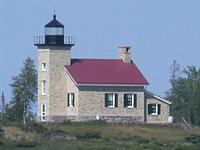
|
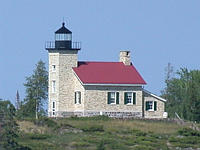
|
| 995 with TC-E2 at 304mm | 995 with TC-E3ED at 300mm |
| Click on the an image to see a larger one | |
Let us look at TC-E3 and Sharp Shooter at 400mm. Note that the on-camera lens must be zoomed in to near the end to get a 400mm shot for 995 with TC-E3ED. However, the on-camera lens is near the short end for a 995 plus the 8x lens to achieve 400mm. Therefore, this puts TC-E3 in a disadvantage position. The left image below is cropped from the center portion of the image taken with 995 and TC-E3ED at 400mm, and the right one is a crop from the one taken with 995 and the 8x lens. The 8x image is a bit soft, and the image quality of TC-E3ED at the longer end is only slightly better than the 8x at the shorter end.
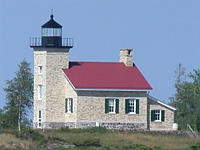
|
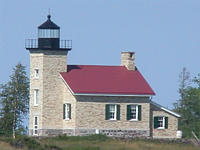
|
| 995 with TC-E3ED at 400mm | 995 with 8x at 400mm |
| Click on the an image to see a larger one | |
Finally, let us compare the 6x and 8x lenses. The following images were taken at 800mm and around 1000mm (i.e., 912mm for 6x and 1000mm for 8x). There is no doubt that the images taken with the 8x are sharper than those with the 6x. For example, the horizontal lines between bricks on the wall of the lighthouse can be seen clearly in all images with the 8x lens; however, the images of the 6x lens are too soft to see these horizontal lines. Compare the texture of the roof and chimney, and you will get the same conclusion. This may be due to the higher contrast of the 8x lens. Also note the tonality differences produced by the lenses. Moreover, both lenses show some pincushion distortion, but not very serious.
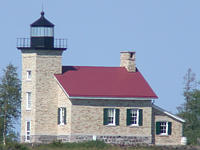
|

|
| 995 with 6x at 800mm | 995 with 8x at 800mm |

|
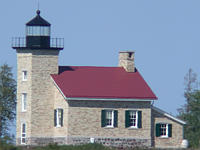
|
| 995 with 6x at 912mm | 995 with 8x at 1000mm |
| Click on the an image to see a larger one | |
The first test is about TC-E2 and TC-E3ED at 300mm. The first column of images shown below are the original ones. The second column shows a small portion of the center, and the third column shows an area near the upper left corner. Images on the second and third columns are cropped from the original images taken in the NORMAL setting and are not edited. The images of the center portion do not show much difference; however, the one taken with TC-E3ED appears to be sharper. The images of the edge portion clearly show that the one using TC-E2 is worse than the one using TC-E3ED. Keep in mind that this does not mean TC-E2 is not as good as TC-E3ED. As discussed in the previous section, this difference is likely caused by the on-camera lens being zoomed all the way in. The image quality of the longer end of a zoom lens is almost universally worse than the shorter end.
| Original | Center | Edge | |
| 995 with TC-E2 at 304mm |
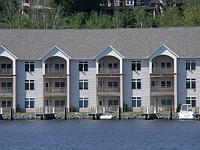
|
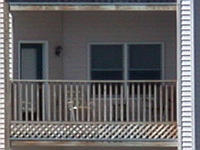
|
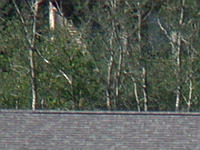
|
| 995 with TC-E3ED at 300mm |
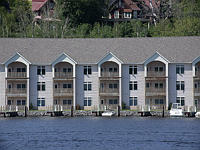
|

|
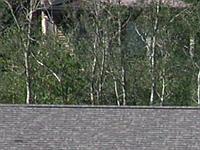
|
| Click on an image to see a larger one | |||
Next, we look at TC-E3ED and Sharp Shooter 8x at 400mm. In this case, the on-camera lens zooms almost all the way in to reach 400mm for TC-E3ED; however, it is only at the beginning for the 8x. This may explain that the pincushion distortion of the TC-E3ED image is worse than of the 8x. As for the center part, TC-E3ED is slightly sharper even though the on-camera lens is at the longer end. The edge portion is another story. That of the 8x lens is so bad. However, I do not see it a serious problem because we perhaps will not use this 8x lens for only 400mm.
| Original | Center | Edge | |
| 995 with TC-E3ED at 400mm |

|
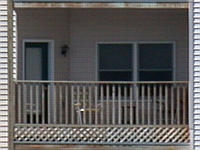
|
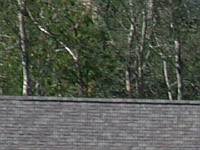
|
| 995 with 8x at 400mm |
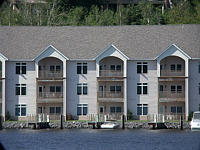
|
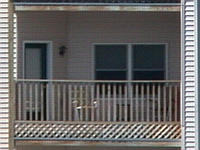
|
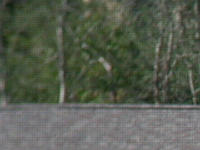
|
| Click on an image to see a larger one | |||
The third comparison is for 800mm. As you can see from the images, the one by the 8x lens is not quite 800mm; but, it is not very far away. Examining the center portion, the 6x is still softer than the 8x. For example, the image definition of the chairs is not very clear. The edge portion is a crop from the middle of the left edge of the original. The image by the 8x lens still looks good, and the center portion and edge portion do not look very different although the latter is definitely not as good as the former. On the other hand, the edge portion by the 6x is poor and the difference between center and edge is significant.
| Original | Center | Edge | |
| 995 with 6x at 800mm |
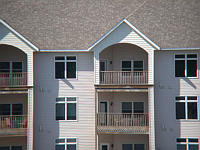
|
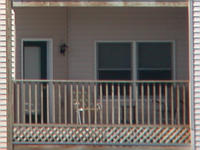
|
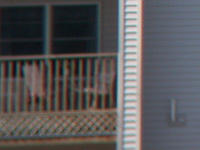
|
| 995 with 8x at 800mm |
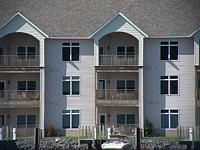
|

|
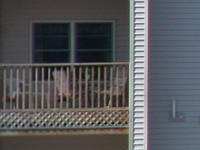
|
| Click on an image to see a larger one | |||
Finally, let us compare the result at the longest focal length (i.e., 912mm for 6x and 1216mm for 8x). Images of the center portion look similar; however, the 8x lens reveals more details. For example, texture of the wooden frame near the lower edge of the image can be seen clearly with 8x; however, it is blurred by the 6x. The lower left corner images are very different. The 8x can still reveal some detail of the object; however, it is unrecognizable in the 6x image.
| Original | Center | Edge | |
| 995 with 6x at 912mm |

|

|

|
| 995 with 8x at 1216mm |
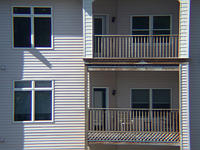
|
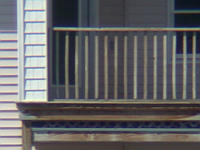
|
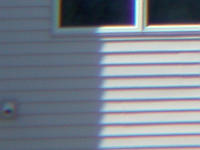
|
| Click on an image to see a larger one | |||
Judged by the images on this page, there is no doubt that images taken by the 6x lens are warmer than those by the 8x lens. However, none of them is correct. The actual color is somewhat between these two and closer to those of the 8x lens. Those by the 6x lens are simply too warm.
A common problem of telephoto lens is chromatic aberration (i.e., color fringe) because the color components are not focused at a point. This problem can be alleviated by using special glasses such as Nikon's ED glass used in the TC-E3ED tele converter. I would assume that the 6x and 8x lenses do not use any special glass because it is not mentioned in the manual. Consequently, we can expect chromatic aberration to occur, especially at the longer end. Normally, chromatic aberration can be seen as a fringe between two high contrast areas. It is usually in blue or red/green.
The following is an example. The images on the second column are cropped from the original images without editing. The marked area is the area you can see color fringes. Judged by these two images, blue fringe between high contrast areas is well-controlled with 6x; however, the 8x shows substantial blue color fringe.
| Original | Cropped | ||
| 995 with 6x @ 912mm |
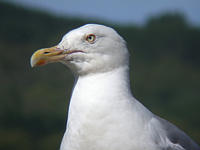
|
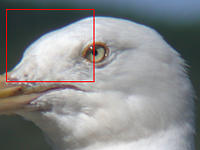
|
|
| 995 with 8x @ 1216mm |
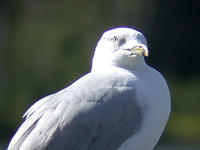
|
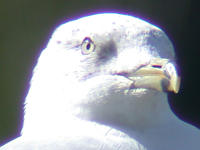
|
|
| Click on an image to see a larger one | |||
The house images used in the second comparison reveal more. Again, the indicated areas show color fringes. Clearly, the 6x has green/red color fringes between high contrast areas; however, the 8x not only has blue but also green/red fringes. It is likely that the designers of the 8x lens emphasize more on sharpness than minimizing chromatic aberration.
| Original | Cropped | ||
| 995 with 6x @ 912mm |
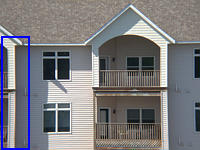
|

|
|
| 995 with 8x @ 1216mm |
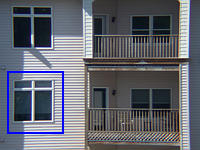
|

|
|
| Click on an image to see a larger one | |||
As we all know, this depends on the macro capability of 950/990/995. However, both Kenko 6x and Sharp Shooter provide sufficient working distance (i.e., the distance between the subject and the front of the camera lens) for light. The closest focusing distances of both lenses are shown below:
| Closest Focusing Distance | |
| Kenko 6x | 23cm (approx. 9 inch) |
| Sharp Shooter 8x | 70cm (approx. 27 inch) |
To see how good the lenses are for close-up work. The left image below, which was taken using 995's macro at its shortest distance (2cm), is used as a benchmark. The Kenko 6x has a minimum working distance of about 9.75 in. The middle image below is taken at this distance. As you can see, its close-up capability is amazing with a reproduction ratio about three times higher than that of 995. The right image is taken with Sharp Shooter at its minimum distance about 27 in. For the Kenko and Sharp Shooter, the 995 on-camera lens is in macro mode with its longest focal length. As you can see, the Kenko has the highest reproduction ratio, followed by the Sharp Shooter. Both are higher than that of 995. Thus, in terms of working distance, the Kenko and Sharp Shooter allow us to have more freedom for lighting.

|
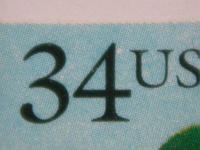
|
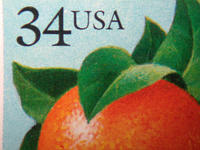
|
| 995 Max. Close-up (2cm) | Kenko 6x (9.75 inch) | Sharp Shooter (27 inch) |
| Click on the image to see a larger one | ||
Image quality is another story. From the above images, it is clear that none of the two monoscopes can deliver the sharpness that a 995 can provide. It appears that 995 has the best quality, followed by the 8x Sharp Shooter, followed by the Kenko 6x. The image produced by the Kenko is too soft and its contrast is too low. To see the details, the following images are cropped from the original. Keep in mind that "34" is slightly off-center for the Kenko 6x, and is near the edge for 995 and Sharp Shooter. Thus, this test is not entirely fair, because we are testing the center portion of the Keno against an edge portion of the 995 and Sharp Shooter. However, it turns out that this does not matter, because even close to the center, the Kenko 6x does not provide the details we can see from 995's smaller image. The Sharp Shooter is a little better than that of Kenko 6x. In summary, while the Kenko 6x does have an amazing close-up working distance, its image quality wipes out this advantage almost completely.
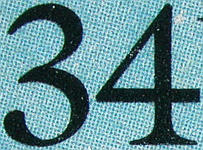
|
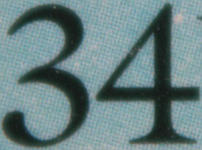
|
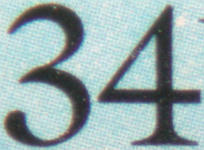
|
| 995 Max. Close-up (2cm) | Kenko 6x (9.75 inch) | Sharp Shooter (27.6 inch) |
| Click on the image to see the original size | ||
From the above discussion, it is clear that the Sharp Shooter 8x monoscope is sharper than the Kenko 6x in all usable focal lengths. However, the 8x suffers more serious chromatic aberration problem than the 6x does. Is the 8x for you? It depends. The 8x is bigger, heavier, higher magnification, brighter, more expansive, and causing problems when focusing. If you can live with these issues, you will like the 8x. On the other hand, the 6x is so small and light, you can even put it in your pocket. Moreover, if you do not mind its softness, it is also a good macro lens with a larger working distance than that of a 995.